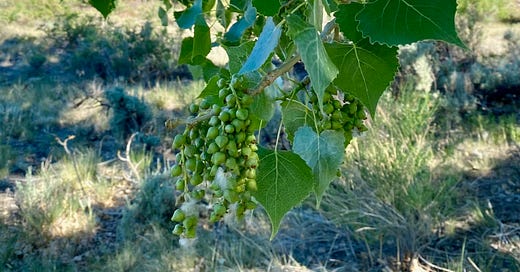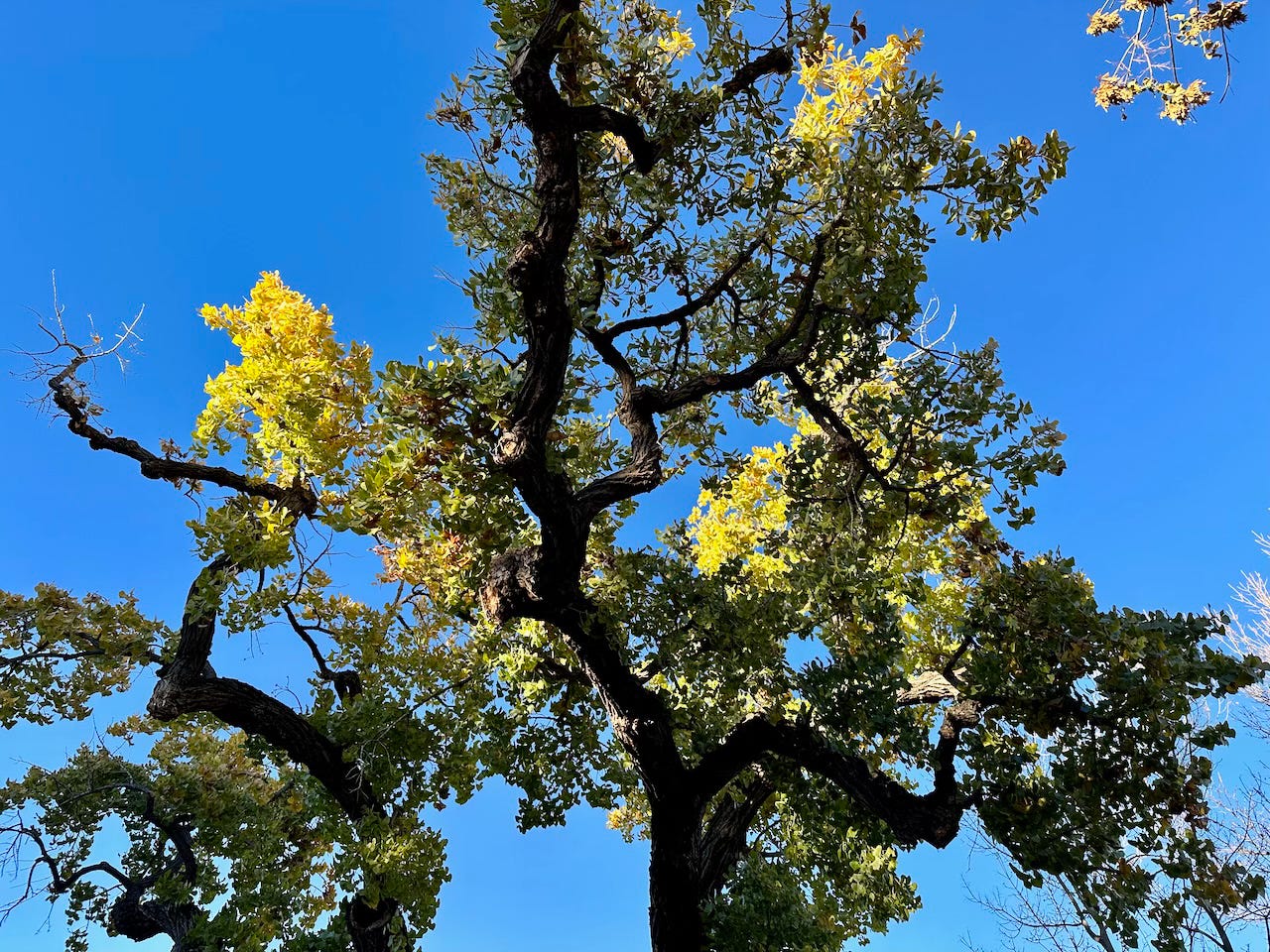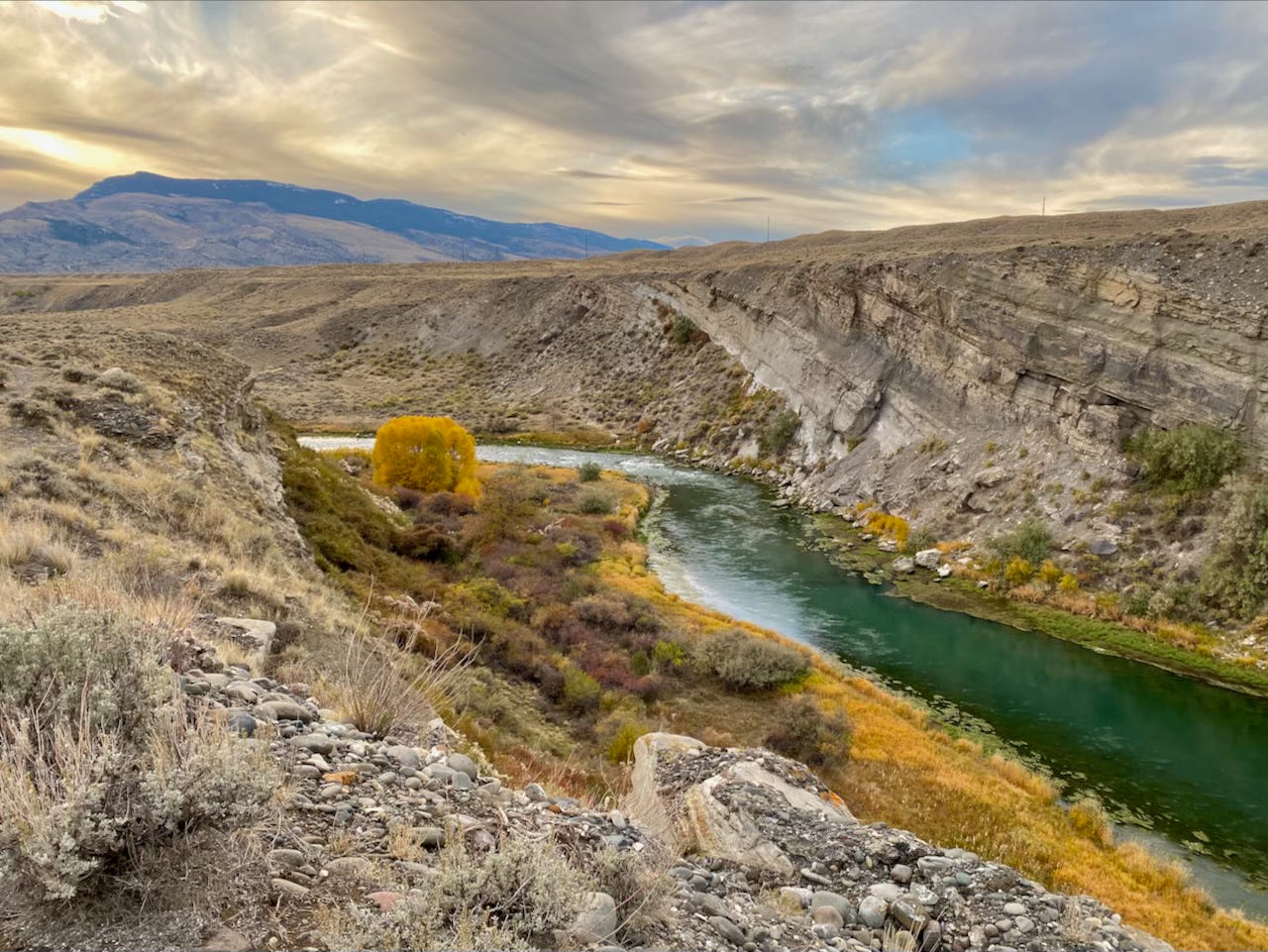grandmother cottonwood limbs pruned into gnarled shapes beautiful age
Because I am moving this week, my tenth move in as many years, I have been thinking about home, a subject I’ve been exploring for decades. Hence these thoughts, inspired by yesterday’s visit to an old cottonwood tree in downtown Santa Fe that I first got to know more than half a century ago, when the tree was already old, but I was a young girl. (That’s the tree—or what remains of her canopy—in the photo at the top of the post with the accompanying haiku.)
I was born and raised in the Midwest, but I discovered the region I call home on family vacations when I was still in grade school. Our summer wanderings almost invariably took us West, traveling in one of a succession of homemade camper vans, exploring the back roads of the open spaces between the Midwest and the Pacific Coast. We camped, hiked and backpacked across mountains and deserts, rocky plateaus and river canyons.
As soon as we left the Great Plains for the vast, dry spaces of the inland West, where trees lived only along the rare rivers and streams, where rain was an event to celebrate because it brought the landscape to life and mountains bordered the horizon, I came alive.
Where big sagebrush perfumed the air with its camphor and sweet orange fragrance and cottonwood trees rustled with the promise of water, I danced atop sandstone boulders in dusty sneakers, raced my brother up switchbacking trails (he always won), sung echoes into mountain canyons and cooled hike-weary feet in clear streams. I collected cottonwood leaves and sagebrush sprigs and pressed them to remind me of home and happiness.
When I was twelve, my mother took me out of school for a day to see an exhibit of Georgia O’Keeffe’s paintings at the Chicago Art Institute. We climbed the wide stone stairs with the arching colonnade to the main doors, and then the polished staircase to the second floor. When we entered the gallery with O’Keeffe’s paintings, I stopped, stunned. There, inside the great gray building under gray Midwestern skies, was home: the brilliant light, the expanse of open landscape, the colors and forms of the rocks, the incandescent green of spring cottonwoods….
Looking at those canvases, I resolved that as soon as I could, I would move West to live with cottonwood trees and big sagebrush.
And I did, leaving the Midwest while I was still in college to work in Yellowstone National Park, and eventually to marry and settle in northwest Wyoming. But a series of life events—a diagnosis with a chronic, potentially fatal illness followed by a divorce—sent me away.
I went to graduate school, fell in love with Richard, my second husband, and his small daughter, and followed his career from Wyoming to West Virginia to Washington state to Colorado to Iowa to New Mexico and back to Colorado. In each place, I did my best to make a home for the three of us: I learned the landscape, found a favorite old tree to visit, planted a garden for beauty and food, and wrote and mothered and rooted as best I could.
I was happy in each place where we lived, but never really home in the sense of rooted where I knew I could go old. In the sense that I could imagine become part of the place after death, the molecules and atoms of what I call “me” disarticulating into the soil, loosed to become part of the cycle of life there.
Thanks for reading this reflection on home. What follows is a deeper dive into what home means and how we can belong and reciprocate for the gifts we receive from the planet and our fellow inhabitants.
It wasn’t until after Richard died and there was no more “us” to make a home for that I realized I no longer knew where home was for this solo me. I no longer felt that strong sense of home I had in childhood. That bright certainty of where I belonged had been dulled by our moves over the years, by layers of compromise involved in making a family out of disparate pieces.
What I learned is that home for me involves a complex set of cues that add up to a feeling of belonging. To the human community and also to the community of the land, the more-than-human world we call nature. Home is not so much a place to live as a process of becoming part of those communities. An intention to give back, to create a reciprocal relationship with place and community. Home is doing, not just being.
Home is where, as I wrote in The San Luis Valley: Sand Dunes and Sandhill Cranes:
… We give as much as we get, the way flocks of sandhill cranes fertilize the ground where they feed and roost, any place where our voices linger in story and song and the memories of our sojourn stir hearts long after we are gone, regardless of whether we were born there or how long we stay.
“Home is where we give as much as we get….” In other words, home is an intention and action, home is doing the work of creating a reciprocal relationship with place and our fellow inhabitants. Home is a verb as well as a noun.
Reciprocating can take many forms, from nurturing your neighbors on a personal level to volunteering for community organizations, from tutoring young readers to pulling weeds and maintaining trails, from donating money to writing emails and running for office. It is about honoring and responding in kind to weave our lives into the fabric of the communities we call home.
I am still not sure if Casa Contenta, my name for the house out on the prairie southeast of Santa Fe where I am moving, is my final home. But I know it is the place where I need to be now. For as long as “now” lasts.
So I am moving this week, going home to a neighborhood where I have lived before, where I have longtime friends, to a landscape where I have walked and ridden the trails and learned the community of the land, where I have sweated to remove invasive weeds and make space for native plants to return and reweave healthy landscapes. I am moving home to give as much as I get.
Because for me, home is a verb, a process and an action of reciprocal relationship that roots me in place in these vast landscapes of the inland West, where big sagebrush perfumes the air and cottonwood leaves rustle with the promise of water in an arid land. Home to sing my song into the wind and sun and sky.
What does home mean for you? Where and how do you belong to home?







This is lilting and evocative! Home for me has grasslands in it, wide open untrammeled expanses - the Flint Hills of Kansas - my first “accidental” trip into them as a teenager in a borrowed car - I didn’t want to leave! But also, having moved around a lot, I found other earthy elements that caressed my soul - the Rockies, the woods of New England…home is where I feel small and expansive all at once , where I am am freed to be utterly grateful .
Thank you for sharing this wonderful explanation/exploration of home. As a mid-Atlantic city girl, I was spell bound the first time I visited Santa Fe and knew I had to find out why it felt like "home" to me. Having now lived here for 21 years, I can honestly say it is my true home... on every level. Noun and verb, speaking. And that includes finding you and becoming sisters.